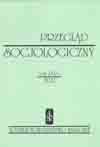Jak w Polsce rozwija się zjawisko niedostępności respondentów? Analiza na przykładzie badań CBOS 1993–2011
How is the nonresponse phenomenon developing in Poland? A trend analysis of nonresponse in Poland in 1993–2011 based on CBOS research
Author(s): Katarzyna Grzeszkiewicz-RadulskaSubject(s): Social Sciences
Published by: Łódzkie Towarzystwo Naukowe
Keywords: nonresponse; contact rate; cooperation rate; individual samples; household samples; PAPI; CAPI
Summary/Abstract: Using AAPOR’s final disposition codes, the author shows trends in nonresponse rates from 1993 to 2011 based on the personal interview survey (CAPI) “Current Problems and Events” conducted in Poland by the Public Opinion Research Center (CBOS). The author shows that since 1993 response rate (RR2) has remarkably decreased (by 40 percentage points) due to nonconatcts and refusals. The findings of multivariate analysis demonstrate that the lower contact rate (CON1) can be explained by changes in sample design (i.e. using individual samples rather than household samples) and interviewer workload. The transition of sampling choices however, positively influenced the level of respondents’ cooperation (COOP4). The adverse factors affecting respondents’ participation are: heavier interviewer workload, a negative social mood and an improvement in the economic situation
Journal: Przegląd Socjologiczny
- Issue Year: 61/2012
- Issue No: 1
- Page Range: 83-111
- Page Count: 29
- Language: Polish

